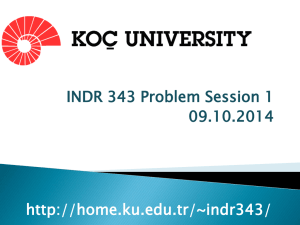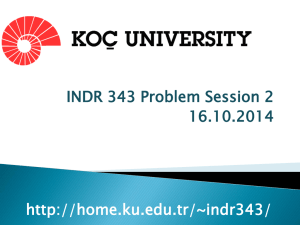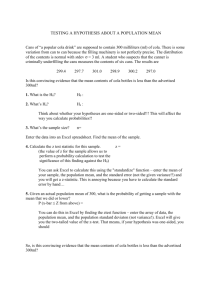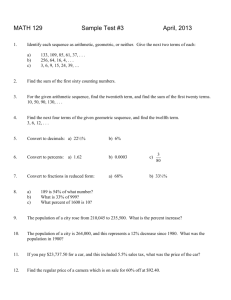Using Spreadsheets to Perform Sensitivity analysis on Decision Trees
advertisement
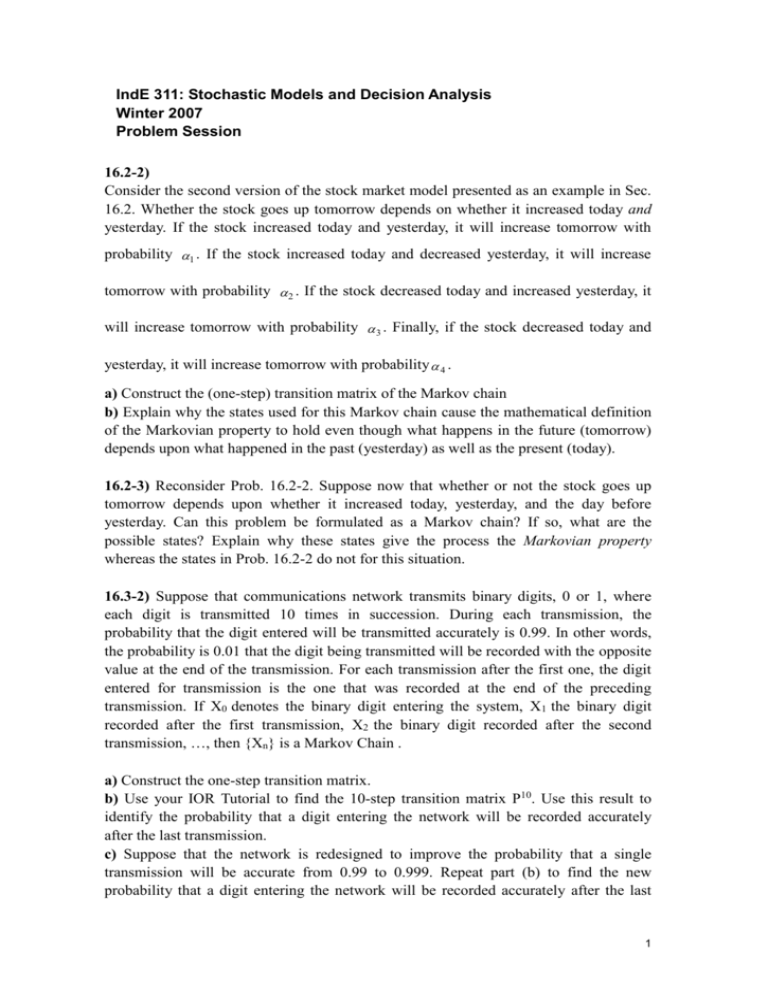
IndE 311: Stochastic Models and Decision Analysis
Winter 2007
Problem Session
16.2-2)
Consider the second version of the stock market model presented as an example in Sec.
16.2. Whether the stock goes up tomorrow depends on whether it increased today and
yesterday. If the stock increased today and yesterday, it will increase tomorrow with
probability 1 . If the stock increased today and decreased yesterday, it will increase
tomorrow with probability 2 . If the stock decreased today and increased yesterday, it
will increase tomorrow with probability 3 . Finally, if the stock decreased today and
yesterday, it will increase tomorrow with probability 4 .
a) Construct the (one-step) transition matrix of the Markov chain
b) Explain why the states used for this Markov chain cause the mathematical definition
of the Markovian property to hold even though what happens in the future (tomorrow)
depends upon what happened in the past (yesterday) as well as the present (today).
16.2-3) Reconsider Prob. 16.2-2. Suppose now that whether or not the stock goes up
tomorrow depends upon whether it increased today, yesterday, and the day before
yesterday. Can this problem be formulated as a Markov chain? If so, what are the
possible states? Explain why these states give the process the Markovian property
whereas the states in Prob. 16.2-2 do not for this situation.
16.3-2) Suppose that communications network transmits binary digits, 0 or 1, where
each digit is transmitted 10 times in succession. During each transmission, the
probability that the digit entered will be transmitted accurately is 0.99. In other words,
the probability is 0.01 that the digit being transmitted will be recorded with the opposite
value at the end of the transmission. For each transmission after the first one, the digit
entered for transmission is the one that was recorded at the end of the preceding
transmission. If X0 denotes the binary digit entering the system, X1 the binary digit
recorded after the first transmission, X2 the binary digit recorded after the second
transmission, …, then {Xn} is a Markov Chain .
a) Construct the one-step transition matrix.
b) Use your IOR Tutorial to find the 10-step transition matrix P10. Use this result to
identify the probability that a digit entering the network will be recorded accurately
after the last transmission.
c) Suppose that the network is redesigned to improve the probability that a single
transmission will be accurate from 0.99 to 0.999. Repeat part (b) to find the new
probability that a digit entering the network will be recorded accurately after the last
1
transmission.
16.5-5)
Consider the following blood inventory problem facing a hospital. There is need for a
rare blood type, namely, type AB, Rh negative blood. The demand D (in pints) over any
3-day period is given by
P(D 0 ) 0.4 ,
P(D 2 ) 0.2,
P(D 1 ) 0.3
P( D 3) 0.1.
Note that the expected demand is 1 pint, since E(D) = 0.3(1) + 0.2(2) + 0.1(3) = 1.
Suppose that there are 3 days between deliveries. The hospital proposes a policy of
receiving 1 pint at at each delivery and using the oldest blood first. If more blood is
required than is on hand, an expensive emergency delivery is made. Blood is discarded
if it is still on the shelf after 21 days. Denote the state of the system as the number of
pints on hand just after a delivery. Thus, because of the discarding policy, the largest
possible state is 7.
a) Construct the (one-step) transition matrix for this Markov chain.
b) Find the steady-state probabilities of the state of the Markov chain.
c) Use the results from part (b) to find the steady-state probability that a pint of blood
will need to be discarded during a 3-day period. (Hint: Because the oldest blood is used
first, a pint reaches 21 days only if the state was 7 and then D=0.)
d) Use the results from part (b) to find the steady-state probability that an emergency
delivery will be needed during the 3-day period between regular deliveries.
Pr. 5) The federal government tries to boost small business activities by awarding
annual grants for projects. All bids are competitive, but the chance of receiving a grant
is highest if the owner has not received any during the last three years and lowest if
awards were given in each of the last three years. Specifically, the probability of getting
a grant if none were awarded in the last three years is 0.9. It reduces to 0.8 if one grant
was awarded, 0.7 if two grants were awarded, and only 0.5 if 3 were received.
a) Express the situation as a Markov Chain.
b) Determine the expected number of awards per owner per year.
Pr. 6) Suppose the entire cola industry produces only two colas. Given that a person last
purchased cola 1, there is a 90% chance that her next purchase will be cola 1. Given that
a person last purchased cola 2, there is an 80% chance that her next purchase will be
cola 2.
a) If a person is currently a cola 2 purchaser, what is the probability that she will
purchase cola 1 two purchases from now?
b) If a person is currently a cola 1 purchaser, what is the probability that she will
purchase cola 1 three purchases from now?
2
